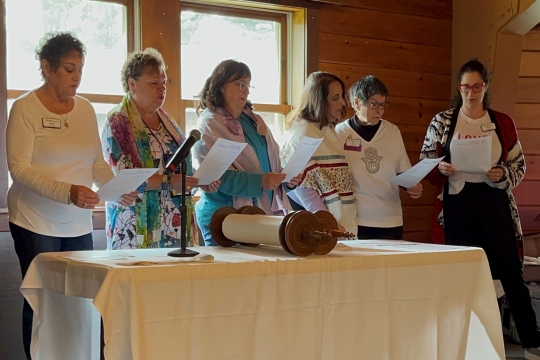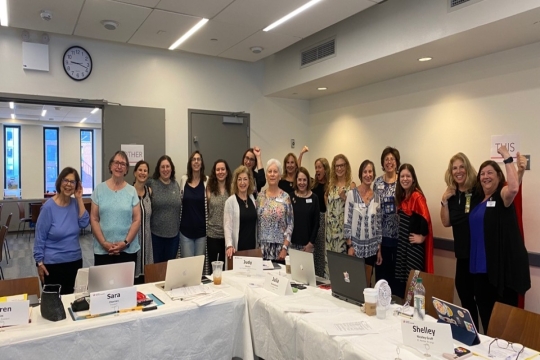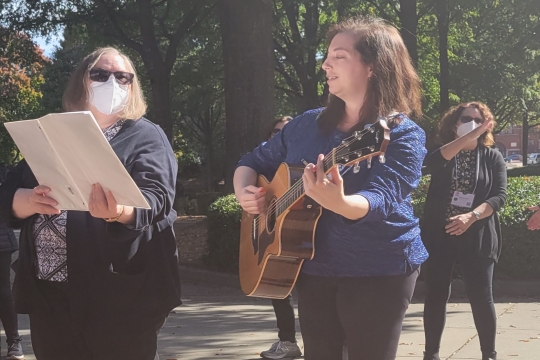
This week’s Torah portion, Ki Tisa, is remembered for its telling of Moses’ ascent up Mount Sinai to receive the Ten Commandments from God and the people’s loss of faith during his absence. Unsure that their leader will return, their fear of abandonment results in acts of unforgivable sins including the construction of the Golden Calf.
Moses left his brother and High Priest Aaron and Hur, son of Miriam, in charge during his absence. Both men were highly respected in the community and had attributes of leadership that seemingly complemented each other. Yet despite this, they lost control and the people transgressed. How did things get so out of hand and are there lessons to be learned to guide us at times when we are called upon to be a leader?
Perhaps both men were unsuccessful because they failed to understand the needs of the people; to put themselves in their places. Although they witnessed the miracles of God through Moses and trusted him to lead them, Moses had not returned from Mt. Sinai when they expected and here they were in the wilderness, forsaken and unsure of their future. Should Aaron and Hur have sensed the people’s restlessness and fear earlier? Newfound freedom after an existence of bondage and its humiliating and dehumanizing effects, with little opportunity to make their own decisions, should have been factored into predicting their inability to have unwavering faith in the absence of their leader or the ability to control their more familiar impulses for idolatry, excess and sin.
Hur tried to stop the Israelites from sinning through strength using condemnation and retribution. The people murdered him.
In contrast, Aaron tried to embrace the will of the people – to serve as the peacemaker. Or perhaps as a witness to Hur’s murder and his perception of his role as High Priest, Aaron decided that giving into the mob instead of convicting their actions would have a better outcome. Perhaps he was looking for a way to calm them down before he could work on restoring their faith. This approach failed and resulted in the creation of the Golden Calf. He allowed the people to turn their backs on God and engage in sinful behavior, ultimately angering God and Moses and resulting in the death of 3,000 Israelites.
If we accept that both men failed in this situation, did Moses’ action as a leader succeed?
In my opinion, it did. Perhaps it was because Moses combined leading through power and strength (for example, showing his displeasure by smashing the tablets) like Hur while using his negotiation skills to become a peacemaker, more like Aaron (convincing God not to annihilate the Jews). However, Moses went beyond these men by gaining the trust of his followers; using compassion to protect them; taking personal responsibility for their wrongdoings; modeling his love of God and the laws bestowed upon them; acting swiftly against wrongdoing when necessary but forgiving human failings; putting the people before himself, and accepting the isolation that making decisions in challenging circumstances can bring.
It is difficult to be a good leader. Some would argue, even more difficult for a woman. According to Agenda: Empowering Women for Gender Equity by Cheryl de la Rey there are two distinct observations of leadership styles attributed to women. One school of thought is that once women engage in their leadership role, they reject traditional female characteristics and adopt styles similar to men. The other, more popular school of thought, proposes that women leaders have a unique style that incorporates nurturing, empathy, good listening skills, and conflict management, to name a few.
After reading Ki Tisa, perhaps we can all benefit from incorporating skills from both these schools as did Moses and lead with a blending of the transactional style most associated with men and the transformational style favored by most women. In other words, should we strive to be strong and task-oriented while building relationships, providing inspirational motivation, building relationships and encouraging communication and consensus? I would suggest that we consider going one step forward by taking the time to observe the people around us to determine what they want and what they need. In my various leadership roles, I have directed those who worked best knowing the hierarchy and then given direct instructions of goal and timeline. Others worked best in a more collaborative environment, working together to create consensus. When evaluating my own experiences, I realized that the superiors I most respected, who motivated and inspired me, were those women and men who seemed to adapt to my own style even when I differed from my peers. Instead of a leader determining their own personal style, perhaps we can be open to input from those around us to maximize desired results.
Women of Reform Judaism supports women in their journey to be effective leaders in their communities through workshops, webinars, tool kits and opportunities to take on leadership roles in their districts and/or the North American board. I have personally benefitted from this continued learning and the wisdom of my sisters throughout North America.
Andrea Stillman is a WRJ North America board member and member of the budget committee, Mid-Atlantic VP of Development and Special Projects, two-term past president and current advocacy chair of her sisterhood, member of Commission on Social Action, temple board member and Chair of the Diversity, Equity and Inclusion Task Force, and member of the Sisterhood of Salaam Shalom. In her spare time, she enjoys the cultural offerings of Washington DC, Mahj Jong, and most of all the company of her family, especially her two grandsons.
Related Posts

Parashat Yom Rishon shel Rosh HaShanah

Cultivating a Culture of Accountability and Belonging


